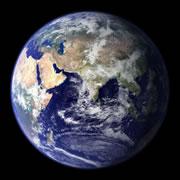 More information means more certainty in our predictions of climate change.NASA
More information means more certainty in our predictions of climate change.NASAIn what may be the most eagerly awaited weather forecast of all time, the International Panel on Climate Change (IPCC) today released its most recent assessment of the state of climate change around the world.
The report, a consensus document put together by 600 scientists and agreed by representatives of 113 countries, predicts continued warming of 0.2 °C per decade for the coming few decades.
Over the twenty-first century it predicts a range of 1.1-2.9 °C warming in a scenario with low emissions of greenhouse gases, and 2.4-6.4 °C in a high-emissions scenario. The warming is expected to be greatest over land and in the north, and the chance of heat-waves increasing in frequency is greater than 90%.
This fourth report by Working Group I of the IPCC — the panel concerned with the physical science of climate change — strengthens the conclusion of previous reports that the principal driver of current climate change is human greenhouse-gas emissions. The previous report, published in 2001, said that the probability that "most of the warming" over the second half of the twentieth century had been due to increases in greenhouse-gas emissions was greater than 66%. The current report puts the probability at higher than 90%.
At the same time, estimates of the role played by another factor in climate change — changes in the amount of solar energy reaching the Earth — have been halved. Changes in solar irradiance since 1750, the panel now says, have amounted to an increase of about 0.1 watts per square metre of the Earth's surface.
The equivalent 'radiative forcing' due to greenhouse gases has increased by between 0.6 and 2.4 watts per square metre over the same period.
"Second of February 2007 in Paris will be the day the question mark was removed as to whether human activity has anything to do with climate change," says Achim Steiner, executive director of the United Nations Environment Programme. "The focus and attention now shift to what on Earth we are going to do about it."
Going up
Increased temperatures, the panel says, will lead to sea-level rises and a likely increase in flooding. The magnitude of those rises, though, is still uncertain given difficulties in modelling the Greenland and Antarctic ice sheets.
It is thought that the amount of global warming needed for the Greenland icecap to become unstable is between 1.9 and 4.6 °C over pre-industrial temperatures. Breaching that threshold would make much greater rises in sea level likely in centuries to come. Antarctica is expected to keep gaining weight, although the slipping of large sections of ice into the sea could reverse this — we just don't know.
The report stresses that some level of further warming and sea-level rise would be inevitable even if greenhouse-gas emissions were to stop growing, and that these effects will last for centuries.
The report also notes a greater than 66% probability that more areas will be affected by drought, and that there will be an increase in cyclone activity.
Unlike the 2001 summary, the 2007 version contains maps showing regional predicted changes — something that modellers have been working hard to produce, and policy-makers have been keen to have. "There is one big advance: we've got more confidence in regional patterns," says Jonathan Overpeck, director of the Institute for the Study of Planet Earth at the University of Arizona, Tucson, and one of the authors of the report.
Late-night session
The 11-chapter review is the end result of years of work that has been scrutinized by more than 620 expert reviewers. The working group's challenge was to assess and weigh the results of previously published papers and decide which findings to emphasize.
ADVERTISEMENT
At the end of this process came the final debate, involving representatives of all the participating nations, to decide how to boil down the study to a 21-page summary for policy-makers1 — the only document that many people are likely to actually read. This kept reviewers up late into the night.
This year Chinese representatives played the strongest role in arguing some of the phrasing in the report, those at the release ceremony for the report in Paris told Nature.
Nature will present a thorough analysis of the report and the current state of the planet in next week's print edition, appearing online by Tuesday 6 February.
This is only the first section of the IPCC's fourth assessment: a report on impacts, adaptation and vulnerability should be finalized in April, and one on ways to reduce emissions or their impacts in May. A final synthesis will be released in late 2007.
Additional reporting by Jim Giles
Visit our newsblog to read and post comments about this story.
-
References
